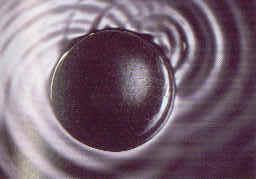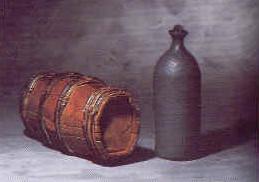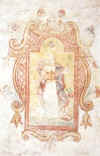FIVE CENTURIES OF THE MINE AND THE TOWN
The central museum exhibition, open in 1995, is entitled
The exhibition covers most of the first floor of the castle. There are ten halls of about 8000 square feet total. The arrangement is topical, not chronological.
HALL 1: MILESTONES OF FIVE CENTURIES
The hall displays the Idrija hallmarks in the form of "triads" each representing a particular theme unique to Idrija. The town owes its existence to mercury; every facet of local life, even lace-making, was connected with the mine operation; and the technical problems in the past centuries required the knowledge of the best engineers and scientists from all over Europe.
-
1. A symbolic depiction of mercury flowing to the world in typical barrels and flasks after the discovery by a tub-maker (1490).
-
2. The town underground: the complicated geology and the shafts (a cross-section by B. Hacquet, 1781).
-
3. The miner (Nikolaj Pirnat, 1933), his tools and the ore, his bread.
-
4. The great men: J. Mrak (1709-1786), the builder of "Klavze"; I. A. Scopoli (1723-1788), the famous biologist and the first mine physician; M. V. Lipold (1816-1883), the geologist and mine administrator from 1867 to 1883.
-
5. The cultural heritage: the Idrija bobbin lace; the first Slovene "non-classical" secondary school; the Theatre and the wheat storehouse from the period of Maria Theresa.
-
6. The technological heritage: the giant water wheels: a two-direction wheel from the 1500's; the water pump "Kamst" (from 1790; largest preserved in Europe); the water barriers ("Klavze", 1700's).
HALLS 2 - 4: THE GEOLOGICAL COLLECTION
 The
Idrija ore deposit geological structure is among the most complicated in
the world, dominated by many nearly vertical faults. This fact spawned
both a strong local geological school, and widespread interest in mineral
and fossil collecting. The present exhibition contains over 700 samples
and is composed from the collections by the Mine, the Grammar School, as
well as private collections.
The
Idrija ore deposit geological structure is among the most complicated in
the world, dominated by many nearly vertical faults. This fact spawned
both a strong local geological school, and widespread interest in mineral
and fossil collecting. The present exhibition contains over 700 samples
and is composed from the collections by the Mine, the Grammar School, as
well as private collections.
-
Hall 2: Fossils from the wider Idrija region, classified by age, from Carboniferous and Permian, to the youngest, Eocene.
-
Hall 3: The central ore collection. The essential points represented are the complicated site structure and the many varieties of the cinnabar ore. For the first time in more than seventy years, the M. V. Lipold collection (from 1853 to 1883) is on view again.
-
Hall 4: The systematic mineral collection, containing samples form all over the world, and serving as a background for the understanding of the local geological features.
HALL 5: DOCUMENTS TELL THE STORY
Idrija's 500-year history is well documented. Besides the Idrija and Ljubljana archives, the majority of the documents are actually kept in archives at Udine, Venice, Vienna, Graz, Klagenfurt, Augsburg, Rome, Nuremberg, Florence, Madrid, Genoa, and Amsterdam. In addition, there have been over 400 works, including monographs, dealing with Idrija, since the 1500's.
The exhibition is introduced by a reconstruction of a mine clerk checking the miners' presence. Of particular interest are excellent maps by the local cartographic school, once renowned throughout Central Europe.
HALL 6: VIEWS OF THE TOWN
The exhibition shows Idrija in its historical development, with stress on the time around 1900, at the end of the Austrian period. Among the views of the architectural landmarks and surface mine facilities, one should note the narrow and tall miners' houses perched on the hillsides of the narrow valley.
The layout of the exhibition allows the direct comparison of the town vistas on old photographs with the views of today's town through nearby windows. The hard labour sustaining Idrija is symbolized by an ore cart, and the six national flags reflect the ever changing local political map.
Idrija is Slovenia's oldest mining town. It developed into a market town in the 1600's, and was the second largest town in Carniola in the 1700's. The town's fortunes peaked just before World War I and after World War II.
HALL 7: "THE MERCURY TOWER"
This hall offers a symbolic descent into the world beneath whence the shiny metal is extracted. The theme of light and darkness recurs in the white lace on dark background. A treasure, a cube filled with drops of mercury (J. Vrscaj), is suspended from the ceiling. The staircase holds displays of machinery, tools, lamps and clothing, providing a representation of the world of the miner.
The Idrija Mercury Mine was the second largest in the world. In 500 years it produced 107,000 tons of pure mercury, which roughly corresponds to the volume of the castle courtyard up to the rooftops. This represents 13 % of the cumulative world production. The amount of rock mined was almost a hundred times larger. The shafts dug add up to about 700 kms.
HALL 8: FAMOUS PERSONALITIES
Although located relatively far from the main routes, Idrija saw a constant exchange of educated and skilled people with the Central and larger Europe. This hall presents these people some of which are widely known.
The mine operation had to overcome the problems of the hilly terrain, little surface space, complicated geology and surplus of ground water, as well as health-related problems. The mine administrators, in particular the Austrian emperor, employed the best European experts in technology and medicine (e.g., I. A. Scopoli). In addition the mine and in particular the local flora and fauna attracted world travellers and scientists of many profiles. This together with the market needs created a strong local support for education which persists to this day.
HALL 9: EXTRACTION OF MERCURY AND CINNABAR
 The
Idrija mine, for reasons of economy and transport, was a closed operation
whose end product was pure mercury and cinnabar. During the most
prosperous years 800 tons of mercury and 50--100 tons of cinnabar were
produced annually. The production of cinnabar dyes was a well kept
technological secret.
The
Idrija mine, for reasons of economy and transport, was a closed operation
whose end product was pure mercury and cinnabar. During the most
prosperous years 800 tons of mercury and 50--100 tons of cinnabar were
produced annually. The production of cinnabar dyes was a well kept
technological secret.
The smelting was originally done by open-air burning, then in wood piles. In the 1600's retort furnaces were used, and in the 1700's Spanish furnaces appeared which were soon modified to a vertical type. In the late 1800's the Czechs Cermak and Spirek designed innovative shaft furnaces which worked until the 1960's when replaced by the largest rotary furnaces in the world for mercury smelting.
HALL 10: FOREST AND WOOD MANAGEMENT
The mine required large quantities of local wood for construction which had as consequence a traditionally very efficient forest management which in turn served as a model in Austria. Feudal forests were gradually converted to mine property. In the 1700's the mine owned 9500 hectares of forests, which dropped to 7500 hectares after the Land Reform in Austria. Around 1800 the mine employed about 300 foresters. Around 1900 30,000 cubic metres of wood were required annually.
A unique system of wood transportation was used. The nearby streams were dammed with "Kalvze", which were used to produce bursts of water to flush logs to the town, to be picked by the wooden "combs" spanning the river.
HALL 11: SOCIAL LIFE
The photographs in this hall present the Idrija community as a relatively closed society, which through the regular contacts with the outside world managed to develop a complicated structure including good education and culture, and several institutions of the social state.
The three social classes, the mine administrators, the middle class, and the miners, managed to coexist in an orderly society for centuries. The self-assistance "Fraternal Society" operated from about 1700; the Miners' Band since 1665; the Theatre since 1770.
The Lace-making School was established in 1876. Since the 1750's, Idrija boasted of the best popular school in Carniola. The vocational schools tradition peaked with the establishment in 1901 of the first Slovene "non-classical" secondary school.
At the end of the nineteenth century, there were 27 societies, from various sports and cultural associations to the unique "General Consumer Society" monitoring the supplies. The political life was dominated by the Catholic, Liberal, and Social Democratic parties.
A place of honour is occupied by the Luigi Micheletti Award for the Best European Technical Museum, awarded by The European Museum Forum, EMYA, in 1997.
HALL 12: PAINTINGS BY J. TROST
Janko Trost (1894--1975) was the first principal of the Municipal Museum after the World War II, and was active in education, ethnography, topography, and various arts including painting. The paintings exhibited were made for the Museum, as was a series of models of past technological devices. Paintings:
-
Cooking charcoal
-
Smelting ore in piles, beginning of 1500's
-
Miners, mid 1600's
-
Old water dams ("Klavze"), made of wood and stone
-
Slide for transporting wood
-
J. Mrak's "Klavze" on the Idrijca river, 1772
-
Floated logs at the "combs"
-
Pack-horse owners in the mid 1700's
HALL 13: WRITER FRANCE BEVK MEMORIAL ROOM
France Bevk (1890-1970) was born in Zakojca near Cerkno and is ranked among the most prolific Slovene authors for young readers. Among his two hundred works are stories depicting life of children and young people in the harsh local peasant milieu, and of the struggle of the Slovenian minority across the border in Italy for survival of its culture. France Bevk's widow donated to the Museum the writer's library of about 2000 books as well as furniture from their Ljubljana apartment.
HALL 14: DR. ALES BEBLER MEMORIAL ROOM
The Idrija native and lawyer Dr. Ales Bebler (1907-1981) took part in the Spanish civil war and held important posts in the National Resistance Movement during WW II. During his post-war diplomatic career he served as Ambassador to the UN, France, India, and Indonesia.
HALL 15: PAINTINGS DONATIED BY VALENTINA ORSINI MAZZA
Valentina Orsini Mazza, born in Idrija in 1914, established herself in Rome, Italy, as cultural worker, translator and gallery owner. This hall displays 33 of the 100 works she donated to the Museum.
The well-off farmers' houses in the Idrija and Cerkno surroundings were painted with religious and decorative frescoes by popular artists especially in the 18th century. The best frescoes were transfered to the Museum after 1976 for preservation.
HALL 17: LIFE OF THE IDRIJA MINER
 On
display are furniture and appliances of a typical miners' family kitchen
and bedroom from the beginning of the 20th century.
On
display are furniture and appliances of a typical miners' family kitchen
and bedroom from the beginning of the 20th century.
HALLS 18-19: IDRIJA LACE
There
is a rich history of bobbin lace-making in Slovenia. Its origins can be
traced to Germany and Bohemia. The oldest Slovenian document referring to
lace appeared in 1696 in Idria. After women began losing jobs at the mine
due to technology improvements in the 17th century, the number of
lace-makers  started to increase. In 1752 the Mine Director, Anton
Haubtmann, reported to the Vienna Court that ... the Idrian female world,
young and old, is interested in nothing but lace-making."
started to increase. In 1752 the Mine Director, Anton
Haubtmann, reported to the Vienna Court that ... the Idrian female world,
young and old, is interested in nothing but lace-making."
The Idrija lace is distinguished by its design patterns and technique used. The trade with Idrija lace became Europe-wide after the establishment of the Lace School in 1876 which attracted pupils from a wider region.
The lace is made on the "bula," a stuffed cylindrical cushion where the lace design on paper, called "papirc," is pinned up. The bobbins ("kleklji") are used to interweave several threads into various knots and braids held in place by additional pins during work. "Bula" is placed at suitable angles in a woven basket called "jerbas," which also serves as repository for pins, tatting needles and spare bobbins wound with thread ("cvirn"). A special small table is part of the equipment.
Lace is used for interior decoration as tableclothes and napkins, curtains and bedclothes, and in women's fashion. Similarly, it is used for altar decoration and in priests' garments ("alba")
The central exhibit is a hand-made tablecloth of 3 metres by 1.5 metres in size. It was finished in 1977 for President Tito's spouse Jovanka Broz and designed for a 12-person table. It took fifteen to 20 persons and 5000 hours of work to make it over a period of six months.
(Source: Carmina
Historica and R.K.).
Open: Every day 9 am to 6 pm.
